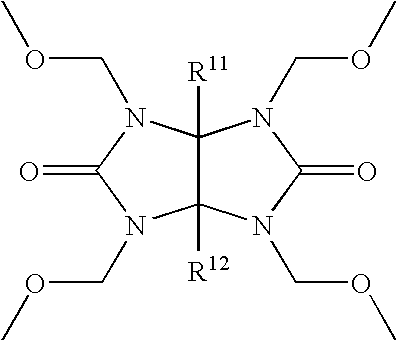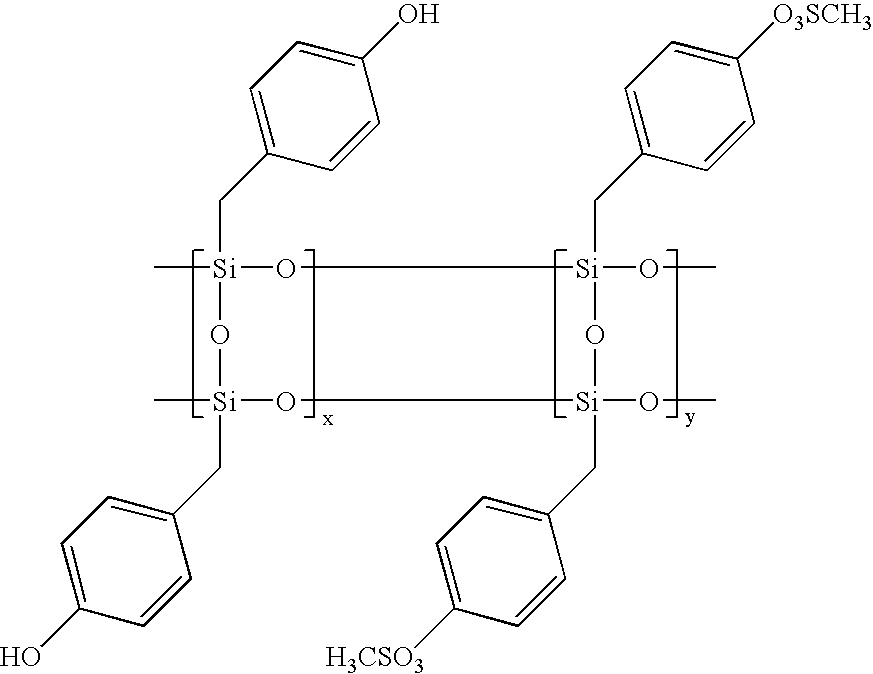Multilayer photoresist systems
a technology of resist thickness and diffusion step, applied in the field of multi-layer photoresist systems, can solve the problems of increasing resist thickness over diffusion step on substrate, affecting the focus of exposure tools, step and scan tools,
- Summary
- Abstract
- Description
- Claims
- Application Information
AI Technical Summary
Benefits of technology
Problems solved by technology
Method used
Image
Examples
example 1
Underlayer Composition of the Invention
[0096]An underlayer (bottom layer) composition of the invention is prepared by admixing the following materials in the specified amounts:
Resins
[0097]Poly(vinylphenol) having mesyl substitution
[0098]Terpolymer containing polymerized units of methylmethylacrylate / anthracene acrylate / ethylhydroxyacrylate
Crosslinkers
[0099]3-methyl-6-propyl-tetramethoxy glycoluril (in an amount of 4.5 weight % of resin component)
[0100]hexamethoxymethyl melamine (tradename Cymel) (in an amount of 5 weight % of resin component)
Acid Generator
[0101]Dodecylbenzene sulfonic acid (tradename Nacure 5225) (in an amount of 0.5 weight % of resin component)
Surfactant
[0102]Siloxane surfactant (in an amount of 0.3 weight % of resin component)
[0103]90:10 v:v blend of propylene glycol monomethyl ether:ethyl lactate (to provide 90 weight % fluid formulation)
example 2
Photoresist Preparation
[0104]Part A. Silicon-containing Polymer Preparation.
[0105]Part 1.
[0106]Poly(4-hydroxybenzyl silsesquioxane) (254.7 g) is dissolved in 1000 mL dry acetone under nitrogen atmosphere in a dried 3 L flask (reactor). Methanesulfonyl chloride (23.8 g) is added and the reactor is cooled to 15° C. A solution of distilled triethylamine (21.9 g) and acetone (22 g) is gradually added dropwise over 20-30 minutes, maintaining a reaction temperature of less than 30° C. Stirring is continued for 3 hours, at which time the solution is added dropwise over 2 h. to 32 L of water, precipitating the polymer. The polymer is then collected by suction filtration, and suspended in 8 L of water with stirring at room temperature for 18 h. The solid is then collected by suction filtration, is washed with water until the effluent is pH neutral, air-dried for 48 h., and is then dried in vacuo for 24 h. at 70° C. to yield an off-white polymer, having the formula 95 mol % hydroxybenzylsilse...
example 3
Multilayer Photoresist System
[0113]The underlayer composition prepared in Example 1 above is spin-coated onto an 8 inch silicon wafer and baked at 175° C. for 60 seconds to remove solvent and provide a crosslinked coating layer.
[0114]A silicon-containing photoresist of Example 2 above is applied over the thus thermally treated underlayer by spin-coating. This sample is spin coated on a wafer, is baked at 90° C. for 90 seconds, and is then imaged on an ASML 0.63 NA DUV stepper using a Global 5-Line reticle and annular illumination (0.85 outer, 0.55 inner).
PUM
| Property | Measurement | Unit |
|---|---|---|
| wavelength | aaaaa | aaaaa |
| wavelengths | aaaaa | aaaaa |
| thickness | aaaaa | aaaaa |
Abstract
Description
Claims
Application Information
 Login to View More
Login to View More - R&D
- Intellectual Property
- Life Sciences
- Materials
- Tech Scout
- Unparalleled Data Quality
- Higher Quality Content
- 60% Fewer Hallucinations
Browse by: Latest US Patents, China's latest patents, Technical Efficacy Thesaurus, Application Domain, Technology Topic, Popular Technical Reports.
© 2025 PatSnap. All rights reserved.Legal|Privacy policy|Modern Slavery Act Transparency Statement|Sitemap|About US| Contact US: help@patsnap.com



